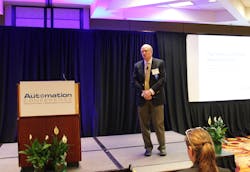Constructive Disruption: A Vision of Smart Manufacturing
General Mills started its smart manufacturing journey in 1993. The first step was to network all of its plant floor equipment, PLCs, and devices. The company also had a Unix-based manufacturing intelligence system, because, at that time, they wanted to answer the question: “How are we doing?”
The problem was, they didn’t know how much data they needed, so they sucked it all up in what Jim Wetzel, General Mills’ director of global reliability calls “the vacuum cleaner approach.” But even with all of that data, all they could do was look-- as they didn’t have access to production reports, system efficiency trends, or overall equipment effectiveness (OEE) information.
Twenty-two years and 700 billion data points later, the global food manufacturer has much more insight into what that massive amount of information means.
During his keynote this week at The Automation Conference in Chicago, Wetzel outlined the steps General Mills took over two decades to move the company closer to its smart manufacturing vision.
What is smart manufacturing?
“For us it is trending [data] in the cloud for traceability, transparency, and visualization,” says Wetzel. “It is networking the supply chain, and shortening the time to get actionable information on the plant floor.”
And, it is positioning the company to be ready for the Internet of Things (IoT), which Wetzel says will be a “constructive disruption” to the manufacturing industry. In other words, IoT is disruptive technology that will get us to places we haven’t yet been.
To deliver on this vision for General Mills and other manufacturers, Wetzel took a proactive position as the Chair of the Smart Manufacturing Leadership Coalition (SMLC), a non-profit organization comprised of manufacturers, suppliers, universities, and federal agencies. The group is collaborating on a scalable platform that will drive industrial competitiveness. The goal is to enable companies of all sizes to gain easy, affordable access to modeling and analytical technologies that can be tailored to meet cross-industry business-case objectives without having to retrofit existing systems.
SMLC started in 2006 with a group of thought-leaders gathering at a workshop in Washington, D.C., and sharing war stories of how painful it was to create an interconnected ecosystem. SMLC was born from those discussions, and, perhaps more importantly, a challenge by the Department of Energy (DOE) for the group to deliver on their vision. So the coalition submitted a proposal to build out a smart manufacturing pilot-- funded by the DOE--- to drive down energy consumption in manufacturing.
Today, a few more pilots are in place, and the way these companies have been able to simplify the ecosystem is by using cloud technology for delivering apps, including data collected from the Internet of Things. The SMLC's framework is taking real-time data from sensors and figuring out how to add context so that apps can be created to do something-- to act on the information.
“At the end of the day, smart manufacturing is not about just getting connected, but getting connected so that you can do something to add value and optimize operations,” says Wetzel.
The measure of success, Wetzel says, is having the ability to deliver value and evolve with changing business using a technology infrastructure that is supportable, quick, and delivers information that can be trusted.
General Mills is applying the developing smart manufacturing framework to its own operations, and, as a result, can easily answer the question “How are we doing?”
Now, Wetzel has a different question—one he asked the audience at the end of his presentation: “Are you ready for this journey?”

